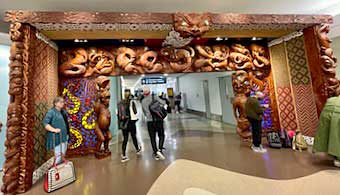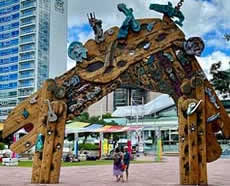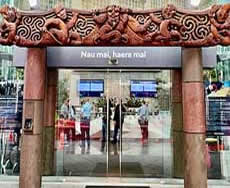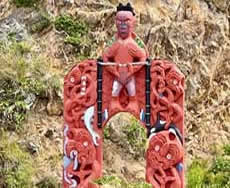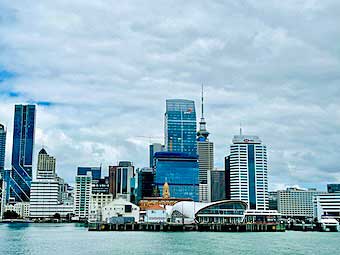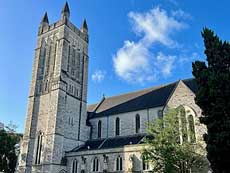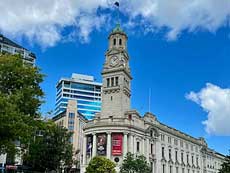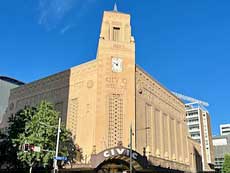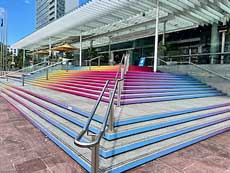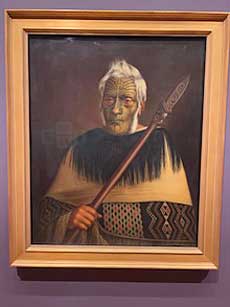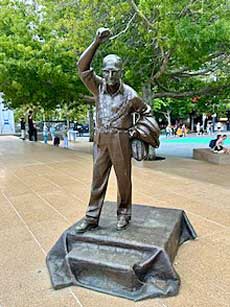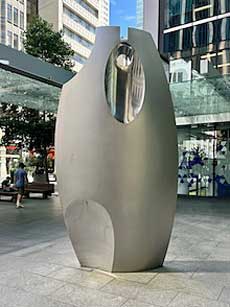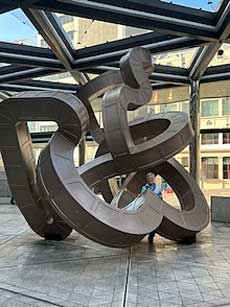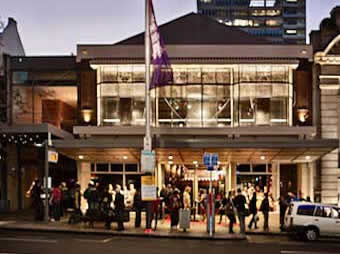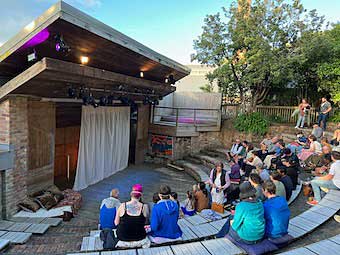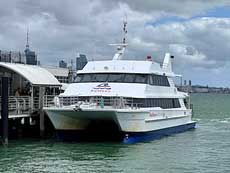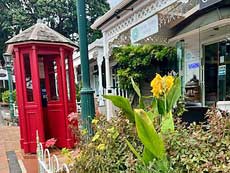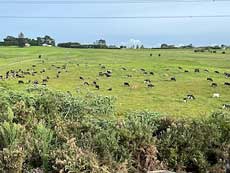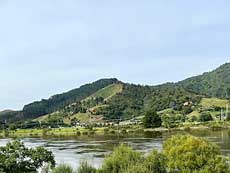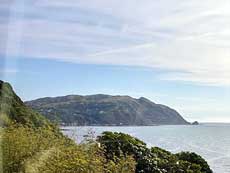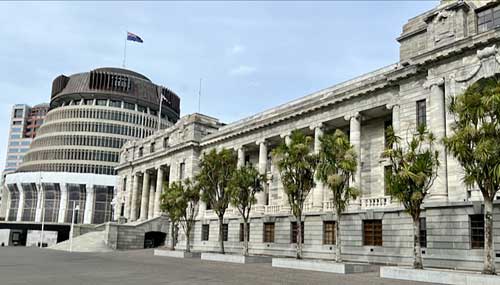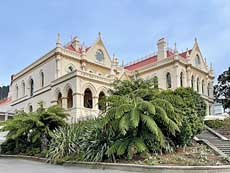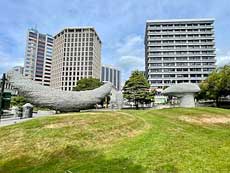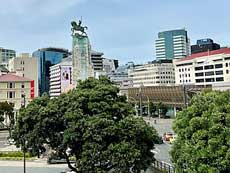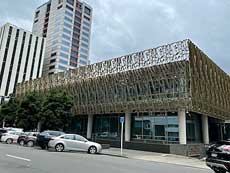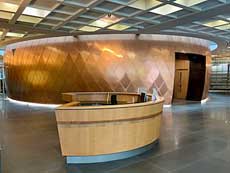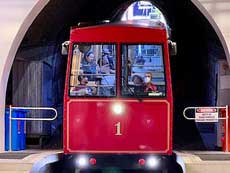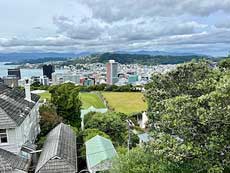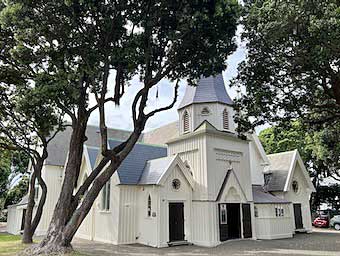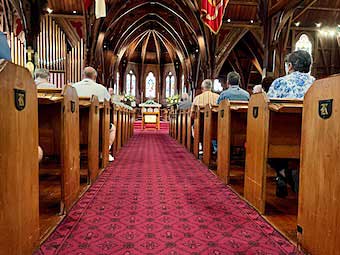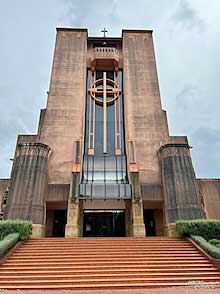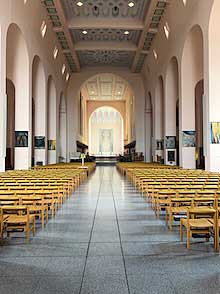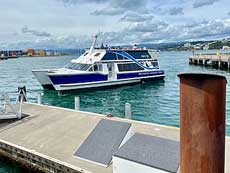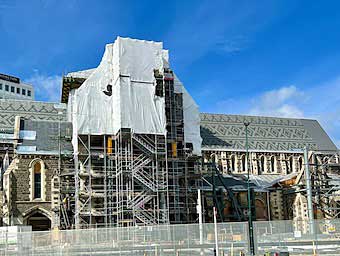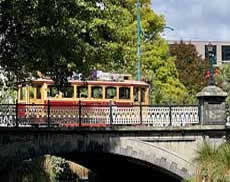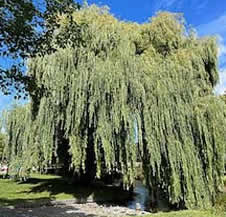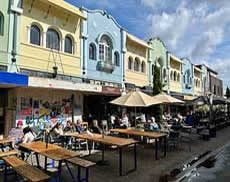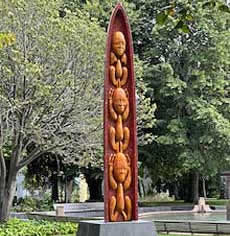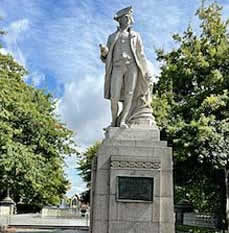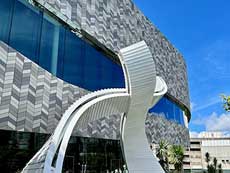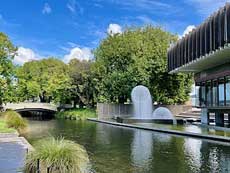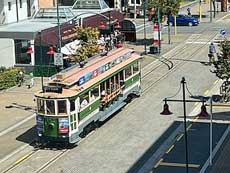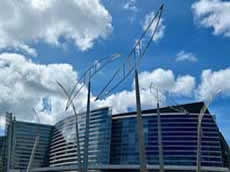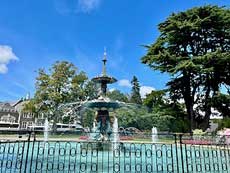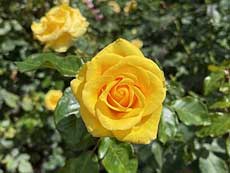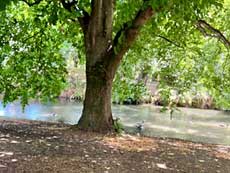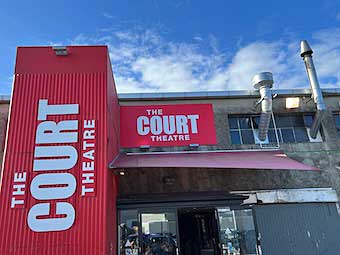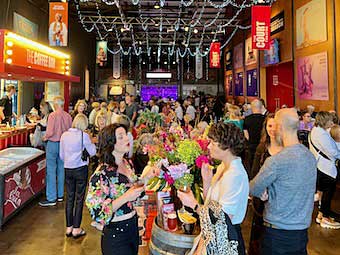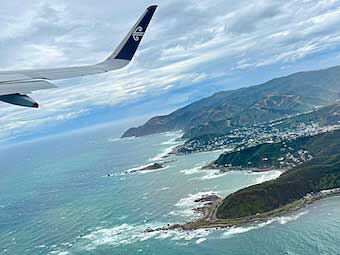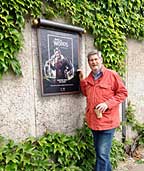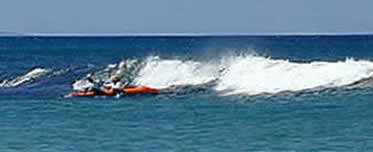 |
|
URBAN NEW ZEALAND |
|||
Story and photos by Brad Hathaway |
New Zealand is famed for its scenic beauty—but we missed much of that in our visit to Kiwi Land in the Southern Hemisphere. A “tropical cyclone” cancelled our sail across Cook Strait and our subsequent railroading throughout South Island. Instead, we marveled at the urban treasures of this country which we came to love for its welcoming attitude and genuine sense of inclusion. After twelve hours aboard a New Zealand Air 777-300 ER bound southwest from San Francisco, the first thing we saw in the Auckland airport was a carved wooden gateway greeting us in traditional Māori fashion to Aoteoroa! Aoteorua? The English called it New Zealand, but the Māori people who where here before them, called it Aoteoroa—meaning either “long white cloud” or “long bright world.” Somehow, either would seem an excellent description of this lovely land. We had first been met aboard the flight on New Zealand Airlines with the Māori greeting Kia Ora. It was the first sign we had that the country we call New Zealand has two official languages: English and Māori. In 1987, Māori was granted official status. In Māori the word for the land the country occupies on two gorgeous islands and as many as 700 smaller islands is Aoteoroa.
The Māoris called gateways such as we saw at the airport tomokanga, and their carvings carry a message, much as do the totem poles of the original peoples of Alaska and Canada. The tomokanga at the airport is strategically placed where passengers deplane because its symbolism is said to be of a portal leading from the dark outside world into the light world of the living—just right for those entering beautiful New Zealand from foreign lands. Many such structures can be found throughout New Zealand. One serves as a door lintel in the home of the Auckland City Council, the Civic Quarter building. One by New Zealand sculptor Selwyn Muru dominates the open space of Aotea Square. It is titled Waharoa or Gateway in Māori. We spotted another greeting visitors to an island park in Wellington Harbour. AUCKLAND
We began our visit in the country’s largest city. Auckland is the center of an urban area where over a million and a half of the country’s five million people live. It is on a spot on the country’s North Island where inlets from the Tasman Sea to the country’s west, and the Pacific Ocean on its east, bring their waters as close as two miles from each other. As a result, Auckland, unlike almost any other city in the world, has harbors on both sides, with access to two different seas.
Not all of the prominent buildings are modern skyscrapers. Some lovely older structures give the city a mixture of old and new. An organization known as Auckland Unlimited operates three venues of note. One, the symphonic concert hall is an imposing Edwardian building called the Town Hall. The largest theater in the city is the Civic which presents a mid-twentieth century brutalistic face to the intersection of Queen and Wellesley Streets. Then there is the more modern concert and convention facility called the Aotea Centre dating from 1989.
There are some fascinating individual buildings to draw your attention. The Salt Water Baths, for instance, provide indoor swimming and steaming facilities just a stroll away from the bay.
The Auckland Art Gallery presents two different facades. The older original building is a stately presence on the prow of a hill facing downtown, but by its side the modern extension has a completely different feel.
The collection of the Auckland Art Gallery also features a mix of the traditional, the modern and some excursions into the more experimental. There you can see Māori portraits by Gottfried Lindauer, a modernist rendition of the essence of a waterfall by Colin McCahon or even a room full of items that artists feel represent “walls.”
Auckland — like all of New Zealand — offers an abundance of outdoor art as well, ranging from sculptural portraiture to abstract representation and beyond.
One evening we joined some local theater journalists to catch a performance of one of the shows in the Auckland Fringe Festival. Skin Hunger was a fast-paced, often funny but also troubling examination of the fact that the need for sexual connection doesn’t die when a marriage ends. The play was well-structured and performed with verve by a talented cast of three including its author, Tatiana Hotere, a Brazilian-born actress who is the widow of a Māori man. The performance was in one of the three spaces in the Q Theatre which was designed by Auckland’s own Cheshire Architects and Australia’s William Ross Architects.
Another evening’s playgoing involved a bit more travel. The Shakespeare in the Park performance of their namesake’s Antony & Cleopatra was performed in the outdoor amphitheater constructed out of the former pump house that drew water from Lake Pupuke on the north shore of Auckland Harbor. To reach it we took the Fullers Ferry across to Devonport and spent an afternoon strolling streets lined with Victorian homes, sipping coffee and shopping in a charming business district noting the bright red phone booths housing actual working phones.
The only excursion outside urban areas that Cyclone Gabrielle didn’t preempt for our trip was a lovely train trip from Auckland down to the southernmost tip of North Island. Along the way we caught glimpses of rangeland, lakes in the hill country, and the southern coast.
WELLINGTON Our next destination? The nation’s capital city, Wellington. It is the second largest city in New Zealand with a population over 400,000. At 41 degrees south latitude, Wellington is the southernmost capital city in the world.
This complex is flanked by, among other things, the Victorian architectural gem housing the Parliamentary Library, a modern high-rise of the Ministry of Defense towering over Bolger Park with its three-piece sculpture, Kaiwhakatere or The Navigator, by Brett Graham, and a monument commemorating New Zealand’s dead from both world wars.
Across Lambton Quay from the monument is the new building for the Supreme Court of New Zealand (Te Kõti Mana Nui) which is presided over by Chief Justice Dame Helen Winkelmann. Its oval court chamber is contained within a concrete building sheathed with a screen made of recycled bronze and recycled glass. The chamber itself, is an ovoid shape clad in copper and lined in 2,294 diamond-shaped silver beech panels.
My wife and I are both retired from the legislative branch of the US government, so when our travels take us to the capitals of other nations, we try to sample their legislative life. We had the pleasure of attending a session of New Zealand’s unicameral legislature and had dinner in a restaurant that caters to the members, The Backbencher. It features large puppets of some of the legislature’s more colorful members in recent history.
Down Lambton Quay from The Backbencher is the station of a Cable Car, the nation’s only funicular. It carries passengers nearly 400 feet up to the entrance of the Botanic Garden. After our ride up followed by views over the city, we took a lovely stroll back down through the garden.
Churches old and new grace the city as well. Old St Paul’s church built in 1866 was the Church of England’s parish church as well as a pro-cathedral, meaning it was to serve as a cathedral until one could be constructed. It is a lovely Gothic Revival structure with a warm wooden interior.
It is called “Old” St Paul’s because a new Cathedral of St Paul was built between 1954 and 1998 of reinforced concrete in an effort to be earthquake-resistant. Therefore, it presents a very different ambiance, although still quite inspirational. By the way, we learned that the usual American abbreviation for “Saint” is St. with a period, but that the British abbreviation is St without a period.
Wellington is a harbor city, so we wanted to get a feel for it from the water. We caught a ferry across the harbor with a short stop at Somes Island (Matiu in Māori) and then enjoyed the scene of the city and a sailboat catching the wind.
CHRISTCHURCH Due to the impact of Cyclone Gabrielle we flew out of Wellington instead of taking a ferry across Cook Strait and a train down the coast of South Island. We landed in Christchurch, the lovely city of just under 400,000. It is the largest city on South Island and is a real charmer, although it still bears the scars of the horrendous series of earthquakes between 2010 and 2012. Indeed, the building whose image was most associated with the city, its Cathedral, is still swathed in scaffolding and protective netting.
The best way to tour this city is to hop on the tram that circles the old town, taking you from the Cathedral to the Botanic Garden, past stately weeping willows and into the restored New Regent Street where you can hop off and enjoy a meal.
Christchurch is also a very walkable city. You can stroll from the tram track through Victoria Park with sculptures from both of New Zealand’s traditions: Māori carvings and bronze images of Victoria and of Captain Cook.
Just outside the park are examples of the modern look of Christchurch. On one side you can see their new Convention Center known by its Māori name Te Pae. Across the Avon River is Christchurch Town Hall, designed by Christchurch architects Warren and Majoney. It features an impressive concert hall which was repaired and restored after the 2011-12 earthquake and opened once again in 2019.
Along the tram route, museums old and new can be discovered - a mixture of both as older buildings are put to new uses. The Arts Center in buildings that once housed the Canterbury College, and the Christchurch Boys and Girls High Schools now houses galleries and museums as well as shops, a cinema, bar, and restaurants. At the other end of the spectrum is the Christchurch Art Gallery, which opened in 2002, a very modern building built to earthquake standards which meant it could be used as a civil defense headquarters following the quakes of 2011-12.
The Botanic Garden with fountains as well as plants is another treasure along the tram’s path.
“Tramming” further out of the center city, we found The Court Theatre in a converted industrial building. The theater company is building a new facility downtown, but for now its audiences gather in the old grain shed. We caught a sparkling production of a new adaptation of Jane Austen’s Sense and Sensibility that had the audience laughing all evening long.
But then, alas, it was time to leave - with just one last look at this land before our plane flew over 6,917 miles of water to take us back to California.
ABOUT THE AUTHOR
|
